Reptile & Amphibian
News Blog
Keep up with news and features of interest to the reptile and amphibian community on the kingsnake.com blog. We cover breaking stories from the mainstream and scientific media, user-submitted photos and videos, and feature articles and photos by Jeff Barringer, Richard Bartlett, and other herpetologists and herpetoculturists.
Thursday, December 27 2012
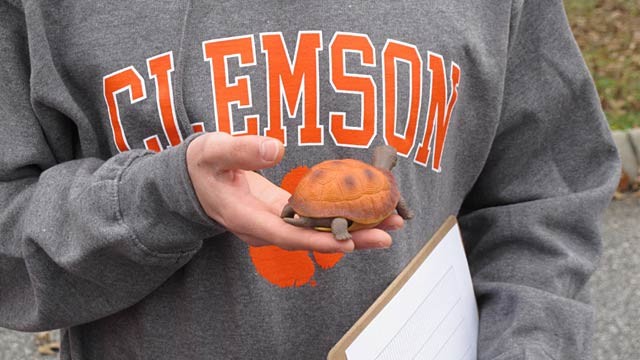 If you've always suspected some people -- maybe even a lot of people -- went out of their way to run turtles over with their cars when they encounter them in the road, now there's data backing up your hunch. From ABC News:
Clemson University student Nathan Weaver set out to determine how to help turtles cross the road. He ended up getting a glimpse into the dark souls of some humans.
Weaver put a realistic rubber turtle in the middle of a lane on a busy road near campus. Then he got out of the way and watched over the next hour as seven drivers swerved and deliberately ran over the animal. Several more apparently tried to hit it but missed.
"I've heard of people and from friends who knew people that ran over turtles. But to see it out here like this was a bit shocking," said Weaver, a 22-year-old senior in Clemson's School of Agricultural, Forest and Environmental Sciences.
To seasoned researchers, the practice wasn't surprising.
The number of box turtles is in slow decline, and one big reason is that many wind up as roadkill while crossing the asphalt, a slow-and-steady trip that can take several minutes.
Read the whole sickening story here.
Monday, December 24 2012
All of us at kingsnake.com wish all of you a very Merry Christmas!
 Photo: From our 2009 "Holiday Herp" photo contest... uploaded by bloodpython_MA. Let him know you liked it here!
Photo: From our 2009 "Holiday Herp" photo contest... uploaded by bloodpython_MA. Let him know you liked it here!
Sunday, December 23 2012
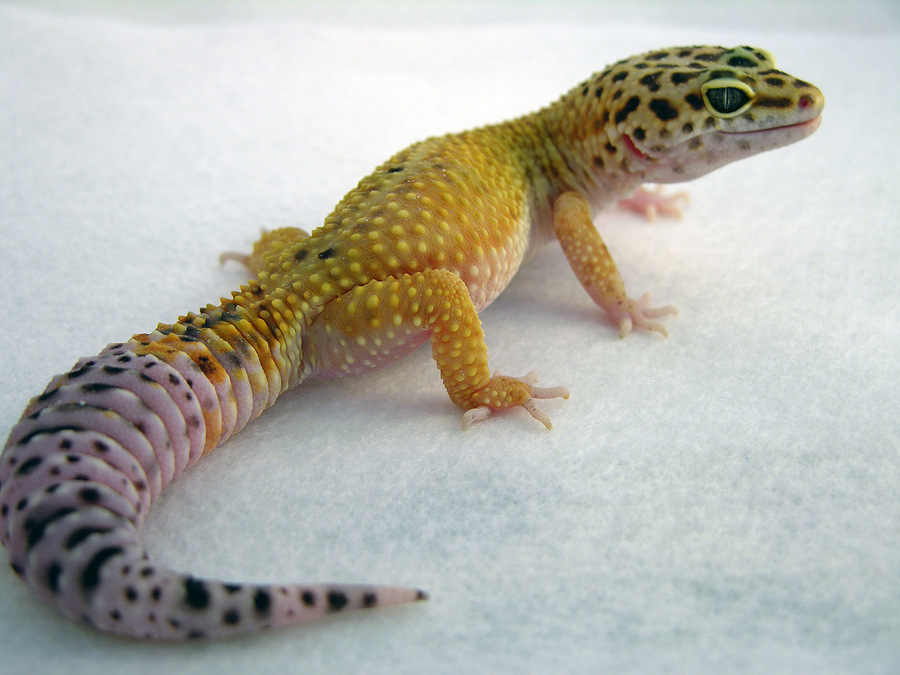 In addition to his super-sticky paws that help him rival Spiderman for climbing sheer walls, the mighty gecko also has a tail optimized for predator-resistance. From MSNBC:
Like a pair of Velcro stripper pants, gecko tails come off easy. The lizards have pre-formed score lines in their tail that allow them to quickly rip off their tails when a predator has grabbed it, according to a new study.
The gecko tails, which were described Wednesday in the journal PLoS One, essentially stick to the body of the animals with adhesive forces.
"The tail contains 'score lines' at distinct horizontal fracture planes where the tail may be released as a response to predation," the authors wrote in the article. "These scores penetrate all the way through the tissue where the structural integrity is maintained by adhesion forces."
The article points out it's long been known that many species of reptile and amphibian shed their tails to evade predators, but this is the first time the exact mechanism by which that occurs has been identified.
Get the story , and, if you're a science wonk, the actual study here.
Friday, December 21 2012
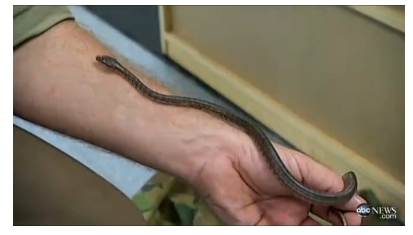 Something strange seems to be happening with snakes and toddlers down under!
After a story earlier this week about a three-year-old boy who tucked a nest of eggs into his bedroom closet only to have them turn out to be venomous snake babies, we've got this: A mama python who birthed her babies in a daycare center. From ABC News:
Australian officials shut down a day-care center in the Northern Territory Thursday because of an infestation of at least 23 baby pythons and their much larger mother.
It all started Wednesday, when a single hatchling Australian carpet python was spotted at the Mitchell Street Childcare Center in Darwin. The following day, seven more little snakes were seen slithering around the community center, which cares for children 6 weeks to five years old.
Director Louise DeBomford called the city of Darwin and two contractors were sent to investigate the issue. They peeked inside the center’s walls and discovered something shocking.
“They found the nest and mum,” DeBomford said.
Their 10-foot-long mom, to be specific. The wall contained a total of 41 broken eggshells, suggesting there were still nearly 20 foot-long serpents unaccounted for.
Amazing, really, that even though nothing happened and the children were not only not scared but responded positively to the snakes, the media still managed to work in a "python eats baby" angle. Read the full story here.
Thursday, December 20 2012
 I don't know what's worse, frankly: the appalling conditions that Global Captive Breeders owner Mitch Behm allegedly kept his animals in, or their fate after the raid made by authorities and animal rights groups, ostensibly "for the animals' protection."
According to an article in today's Sacramento Bee, Behm surrendered all his animals to authorities, and 18,000 rodents and 600 reptiles were "euthanized" as the "most humane option."
Certainly many of the animals, especially the reptiles, could have been placed into the hands of the many rescue organizations geared specifically for treating and caring for surrendered, abandoned, neglected or confiscated reptiles across the U.S. This safety network has long been in place and has been supported by the community for over 20 years, and certainly dozens, if not hundreds, of the reptiles could have and should have been saved.
"A team of veterinarians, reptile specialists and animal cruelty experts determined that because of extreme neglect, cruelty and dangerously unhealthy conditions, euthanasia was the safest and most humane option."
While the article specifically states over 18,000 rodents and 600 reptiles were euthanized, it neglects to mention - how many were saved?
How many of those animals confiscated by authorities survived the raid and were placed into the rescue system?
How much time was actually spent, by experts, examining each of the 18,000+ animals to see which ones could be saved?
Did every single animal die?
Did every single animal have to die?
If someone knows the answers, please tell us.
These are questions we should all be asking. And we should be asking the City of Lake Elsinore. Because they killed those animals. 18,000 of them. Not Mitch Behm.
Lake Elsinore City Hall
130 South Main St.
Lake Elsinore, CA 92530
Phone: (951) 674-3124
Fax: (951) 674-2392
Email: cityhall@lake-elsinore.org
 Yet another kingsnake.com system has undergone an overhaul. This time, it's the reptile and amphibian events system that's had a winter makeover.
No longer just displayed as a long, linking list of events, reptile and amphibian event listings are now searchable by state and province, as well as zip and postal code. A new detailed listing section includes a phone number, the street address of the event, and a map link to help herpers find their way to the event venue.
Further upgrades to the reptile and amphibian events system in 2013 will allow event promoters to manage and edit their listings, as well as add more information about their event. Event listings are still displayed in the old format as well, on the events page, in numerous tabbed locations throughout kingsnake.com, and in the news scroll in the header.
The events system is already chock full of 2013 reptile and amphibian expos and events, so click here and give it a try, and see when the next reptile show is coming near you!
If you have a reptile or amphibian event in 2013 and need to get the word out, listing it in kingsnake.com's event locator system is the best way to reach herpers across the globe. With a 15+ year history of reptile event listings, kingsnake.com is the first place most herpers go to find out where the shows are.
To find out more about how you can list your upcoming reptile and amphibian event, check out the events page at http://kingsnake.com/events.
Wednesday, December 19 2012
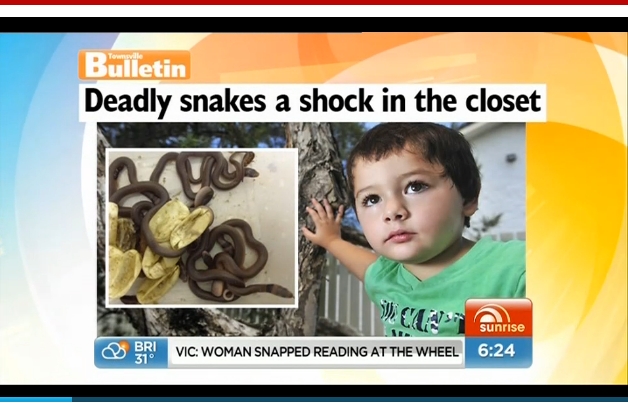 An Australian mom got the shock of her life when she found the eggs her three-year-old son had hidden in his bedroom closet had hatched.
From Yahoo News Australia:
Inside were seven baby eastern brown snakes, considered to be the world’s second most venomous species.
"I was pretty shocked, particularly because I don't like snakes," she said.
Fortunately the lid of the container was on tight and the snakes weren’t yet mature enough to push it off.
Kyle and his mum took the snakes to Billabong Sanctuary where wildlife careers released them back into the wild.
Read the story and watch the video here.
Tuesday, December 18 2012
 Is there a new discovery that might become a weapon in the battle against chytrid fungus?
Chytrid was identified in the 90s as a threat to the existence of frogs and other amphibians, and since then, scientists estimate that more than 300 species have been wiped out by it. A current National Geographic article quotes conservation biologist as saying, "This pathogen is bad news. It's worse news than any other pathogen in the history of life on Earth as far as we know it."
One of the greatest challenges in understanding the fungus has been why it seems to persist in ponds even after all the frogs have died. Now, scientists say they may have at least part of that mystery solved:
Researchers saw it happen many times and were perplexed: If all of a pond's amphibians were wiped out, and a few frogs or salamanders came back and recolonized the pond, they would also die—even though there were no amphibians in the pond to harbor the disease.
One possible reason is that chytrid infects other animals. For a study published today in Proceedings of the National Academy of Sciences, Taegan McMahon, a graduate student in ecology at the University of South Florida in Tampa, looked at some possible suspects and focused on crayfish, those lobsterlike crustaceans living in freshwater.
[...]
The fungus seems to be able to dine on crayfish then leap back to amphibians when it gets a chance. No one knows for sure where the fungus originally came from or why it's been such a problem in recent decades, but this research suggests one way that it could have been spread. Crayfish are sometimes moved from pond to pond as fish bait and are sold around the world as food and aquarium pets.
Read the complete article here.
Photo: National Geographic
Monday, December 17 2012
 kingsnake.com and the Association of Reptilian and Amphibian Veterinarians (ARAV) are partnering to launch a reptile and amphibian veterinary locator service to help people locate local medical services and treatment for their cold-blooded pets.
The full system will be available in 2013, but the current beta version offers links and contact information on reptile and amphibian vets who are members of the ARAV in the United States and Canada. Under the new locator system, herp veterinarians may be located by state or province, or by zip or postal code. Plans for the final release include code that will allow anyone to add the reptile vet locator to their website or page.
"I am looking forward to this very sensible and powerful collaboration." said ARAV webmaster Dr. Katie Heinz-Taheny "The 'portable' search on your page looks good, and will reach an even greater number of herp owners."
The vet locator is one of the many projects in the works stemming from conversations at the September NRAAC Reptile Law Symposium and Workshop in Houston. More collaborative projects are expected to be announced in the coming year between many of the participating companies and organizations. Plans for the 2013 NRAAC conference at the National Zoo in Washington D.C. are scheduled to be announced later this week.
To try out the beta Reptile and Amphibian Vet Locator, visit http://kingsnake.com/vets.html. The full version will be released in January.
Thursday, December 13 2012
 Who doesn't like going to the zoo? For many, their first experience with reptiles and amphibians was at the zoo. I still remember when I was a kid visiting the Cincinnati and Indianapolis Zoos, where the giant tortoises were among my favorites. It left a lasting impression on me and growing up, I never turned down a trip to the zoo.
Now that I'm an adult, when I'm traveling I still like to try to visit the local zoo or aquarium. Over time, I've managed to visit dozens here in the States and in Europe. As an out of towner, however, I often find it difficult to find basic information on the zoo and its location, and without relying on a cab to get there. Sometimes I've found myself lost in a foreign city, wandering about in a rental car asking locals for directions.
kingsnake.com's newest feature, a zoo, aquarium, and wildlife park locator, should help resolve a lot of those issues. This new resource lists AZA-accredited facilities in the United States and Canada by state or province, as well as by zip and postal codes. The locator provides the street address, phone number, website link, and a map link for each facility, to help making your next trip to the zoo a better experience. Check out it out at http://kingsnake.com/zoos.html!
Wednesday, December 12 2012
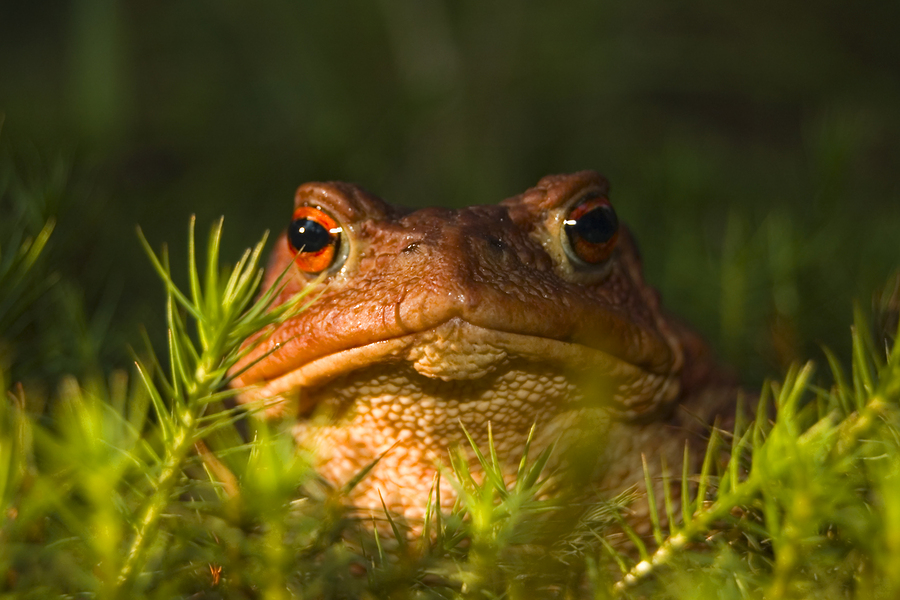 Russian scientists followed a folk remedy's trail and may have stumbled on a substance as potent as modern antibiotics secreted by the skin of frogs. From UPI:
An old Russian way of keeping milk from going sour by putting a frog in the bucket of milk has led to the finding of new antibiotic substances, scientists say.
Organic chemist A.T. Lebedev of Moscow State University and colleagues have identified a number of potential new antibiotic compounds in the skin of the Russian Brown frog, a study published in the American Chemical Society's Journal of Proteome Research reported.
[...]
In lab tests, they said, some of the substances performed as well against salmonella and staphylococcus bacteria as some prescription antibiotic medicines.
"These peptides could be potentially useful for the prevention of both pathogenic and antibiotic resistant bacterial strains while their action may also explain the traditional experience of rural populations," the researchers wrote.
Read the full story here.
Tuesday, December 11 2012
 Science geek? Amphibian lover? Science geek? Amphibian lover? Check out "Culture of an amphibian killer" from Phys.org, an in-depth look at chytridiomycosis, a fungus devastating worldwide amphibian populations. Read more...
More bad news for amphibians: More than 300 amphibians, including some rare frogs, died from the effects of a massive fire at a Polish zoo. Read more...
Dozens of box turtles have fallen victim to ranavirus disease in West Virginia. From WVGazette.com:
Siegel and his Towson colleagues found that an alarming number of turtles -- which can live to be 50 or older and normally have a 98 percent survival rate from year to year -- were dying at the relocation area near the construction site. Thirty-one of the 123 turtles outfitted with the transmitters and released there were found dead within a three-year period. Cars or construction equipment killed three of the turtles, but the rest were felled by disease, which turned out to be ranavirus in 27 cases.
"Finding even one dead turtle is unusual," Siegel said in a Washington Post story about the die-off that appeared earlier this year. "Finding over 27 dead turtles in a two-to-three-year period was bizarre."
In addition to killing the Maryland box turtles, ranavirus is believed to have been the cause of death of nearly every tadpole and young salamander in the study area since spring of 2010.
Get the full story here.
Monday, December 10 2012
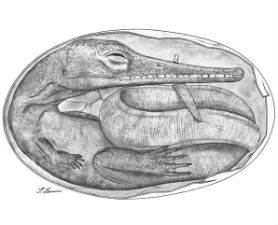 Aquatic reptiles that pre-dated the dinosaurs gave birth to live young and may have been good parents.
In a study published in the current issue of Historical Biology: An International Journal of Paleobiology, scientists look at the fossil records of a species of aquatic reptile known as the mesosaur, which lived around 280 million years ago on the supercontinent Pangaea, which later split into the land masses that include South America and South Africa.
The fossils include retained embryos, suggesting the animals gave bith to live young rather than laying eggs as dinosaurs did. This is often associated with greater levels of parental care being given to the young, something the fossil record also supports, because mesosaurs of various ages were all found together.
From NBC News:
Mesosaurs, and even their earlier ancestors, possibly "were not able to produce hard-shelled eggs, at least for the first several million years of their evolution," lead author Graciela Piñeiro, a paleontologist at Uruguay's Facultad de Ciencias, told Discovery News. "After the recent discovery of mesosaur embryos, we can state with a high degree of confidence that embryo retention developed early in amniote evolution, given that mesosaurs are among the basal-most reptiles and that they date from the Early Permian around 280 million years ago."
Piñeiro and colleagues Jorge Ferigolo, Melitta Meneghel and Michel Laurin recently discovered the exceptionally well-preserved mesosaur embryos at sites in Uruguay and Brazil. The environmental conditions at the locations allowed for the preservation of soft tissues, nerves and blood vessels, she said.
Read the full story here.
Image: Graciela Piñeiro/NBC News
Friday, December 7 2012
When it comes to super powers, the animal kingdom has comic book heroes beat cold.
The Smithsonian has put together a slideshow of animals whose punch packs the most power, including a sticky-pawed little gecko who could out-climb Spiderman with one paw tied behind his back -- as long as it wasn't raining.

Check out Supergecko and the rest of the Supercritters here.
Wednesday, December 5 2012
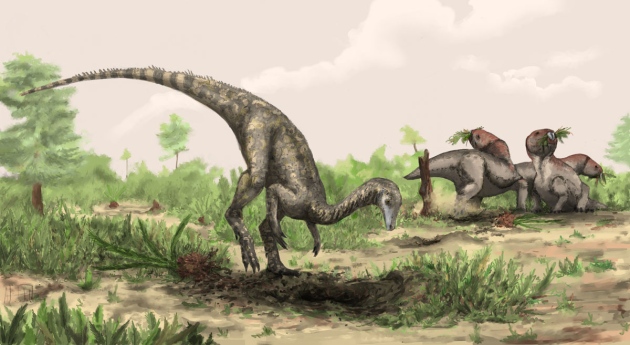 News of the most ancient dinosaur ever discovered broke today, as researchers announced the identification of what they believe is a dinosaur 15 millions years older than any previously identified.
Dubbed Nyasasaurus parringtoni, he was around the size of a Labrador retriever, according to University of Washington palaeontologist Sterling Nesbitt. Read more...
Cold-stunned sea turtles were transported in a donated mercy flight by pilots Gary Davis and Neil McCann. Davis owns Charleston-based Davis Air, Inc. More than 100 cold-stunned sea turtles have been discovered in New England waters since Monday alone, creating a crisis situation for wildlife agencies attempting to care for them. Read more...
And from the California Academy of Sciences, a music video about the world's more than 7,000 kinds of amphibian, as sung by Conor Loughridge and the Wiggly Tendrils. Go watch!
Tuesday, December 4 2012
 The United States has been in the forefront of imposing sanctions on trade with Iran, but draws the line when it comes to a trade ban that might prevent them from treating soldiers bitten by snakes in Afghanistan.
From BusinessInsider.com:
Despite U.S.-led international sanctions imposed to cripple Iran's economy, the Defense Department has purchased about 115 vials of antivenom made by Iran's Razi Vaccine & Serum Research Institute from middlemen for about $310 apiece since January 2011.
Questions from the WSJ have prompted the Pentagon to investigate whether the purchases violate rules of the sanctions and require a waiver from the U.S. Treasury Department.
[...]
"We make this to save lives, and it doesn't matter if the person is Iranian or Afghan or American," Hadi Zareh, lead researcher in Razi's antivenin department, told the [Wall Street Journal]. "We are happy to hear we have saved a person's life, even an American soldier."
Read more...
Monday, December 3 2012
 An EgyptAir flight was reportedly forced to make an emergency landing when a snake hidden in a passenger's luggage bit him.
Don't you just hate it when that happens?
Read more (although there isn't much more) here...
 After a seizure of illegal reptiles by Belgian authorities, a tiny Johnston's chameleon and his twin were born in the UK zoo that took them in:
From Metro UK:
Both unborn brothers, who are just over an inch in length, were on their way to the Czech Republic as part of a consignment of 59 chameleons before the Specialist Wildlife Services intervened.
The chameleons, which are native to the western branch of Tanzania's African Rift Valley, were rescued and placed in different zoos across the UK.
'They are probably the first of this species ever born in captivity within UK zoos,' said Danny Reynolds of Exmoor Zoo in Devon.
Read the full story here.
Photo: Caters/Metro UK
|



